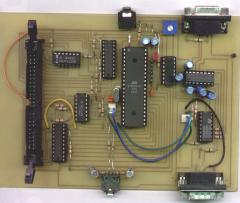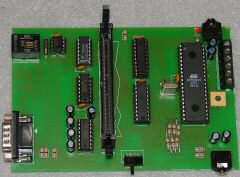The CPC Booster (+) is an extension card for the CPC specialized on I/O features constructed by Antitec / Dirty Minds. It includes components like a very fast serial interface, a music digitizer, a DAC and even a free programmable and useable microcontroller (AVR). It is possible to connect a Bluetooth module transparently to the CPC Booster, which means that you can use the normal CPC Booster software with this solution, too.
Features
This list of CPC Booster+ features has been copied from its homepage
- ONE SYNCHRONOUS/ASYNCHRONOUS SERIAL PORT: Improved serial port (RS232) with the ability to enable parity check, select the bits of the frame, the stop bits and many more things to control it. The speed is from 4800 baud till 1,382,400 bauds.
- SERIAL PORT BUFFER: A 255 bytes buffer added for the UART which can be enabled/disabled by the user. Improves performance of the serial communication.
- TWO ANALOG INPUTS: Two analog to digital convertors. They are used for stereo or mono 8bit sound sampling. You can select the sampling rate directly from the cpc booster.
- TWO PWM CHANNELS: They are used as digital to analog convertors through a LOW PASS RC filter. You can play stereo 8bit samples if you connect the board to an amplifier.
- 5 DIGITAL INPUT/OUTPUTS: You can connect anything that supports TTL logic. You can even drive relays or step motors if you know how to make the appropriate connections. You can also make parallel 4 bit communication with another CPC.
- 512 BYTES EEPROM: EEPROM is like RAM but the contents remain intact if you remove power, it doesn't need a battery.
- 256 BYTES RAM: The booster+ has a 256 bytes buffer to be used for temporary storage of values (like storing the registers).
- SEVERAL MATHEMATICAL FUNCTIONS: At the moment I've only installed multiplication but as soon as I get the time, me and Optimus will write some fast code for division, sin, cos, tan etc.
- BIOS UPDATE: This is one of the best features of the card. It is possible to make an update of the bios of the microcontroller through the CPC. So, when I release new versions of the bios, you can download them, transfer them to the CPC and make an update of the card in a few seconds!
- ROM READ/WRITE: The AVR MEGA16 has 16KB of program memory. The bios of the CPC booster uses less than 5 KB so far. So you can use more than 10KB for your own purposes! You can read/write the program memory of the CPC booster but BE CAREFUL when you write because you may accidentally erase the BIOS data!
- KEYBOARD SCANNING: A function which will make keyboard scanning a lot easier
- TCP / IP IMPLEMENTATION: This is also a feature I want to add in the future in order to give the CPC users the ability to go online in the internet with their CPC! In this part everyone can contribute, if you have knowledge of how the PPP and TCP/IP works, then contact me.
- RS485 NETWORK: An RS485 network is installed in the CPC Booster+. With this it's easier than ever to make a super fast network of up to 32 CPCs, forget everything else you've seen so far. Note: The small 2-position switch allows to select between RS232 and RS485 mode.
- 1 WIRE PROTOCOL: Support for the 1wire protocol is added. Now you can connect many 1 wire devices in the expansion port of the booster, here's a link to get an idea: [1]
Technical
The overall I/O ports are described in the manual (see there).
The documentation lacks some important details though. For example:
- It fails to describe which of the two PWM channels is the left, and which is the right channel - so the the "stereo" feature could be used only when doing some reverse-engineering.
- Some differences between CPC Booster and CPC Booster+ are the type of CPU and the serial interface / networking interface.
Software
- Arkos ROM Pack: [2]
- Some functions of the CPC-Booster(+) are supported by FutureOS.
- Updates to the CPC-Booster software are available as 3 zip files (dated 2 Feb 05, 5 July 05, 28 July 05), though the latest source code appears to be from December 2010. Antitec's web site says to apply them in order. Each update also includes Antitec's terminal application.
- The updates are also saved here: File:Update1.zip File:Update2.zip File:Update3.zip
Manual
- CPC Booster+ manual (Wiki page)
- CPC Booster+ manual (pdf)
Source and Schematics
- The source code, schematics and PCB layout are available here: CPC Booster Plus on cpcszene.de ftp server
- The source code is also kept (and maintained?) with the Linux CPC SDK here: CPC Booster Plus at CPC SDK
- A local copy of the source code/schematics is also preserved here: File:CPCBoosterPlus.zip
- There are also some files available here (don't appear particularly useful): CPC Booster on CPCrulez.fr
- This is the zip file from that page: File:CPCBooster.zip
Notes:
- Latest dated source code is December 2010
- The schematic is not complete, but the PCB layout is
Web links
- Dirty Minds website (Seems to be down 14/05/13 - try here Antitecs website)
- Connecting a Bluetooth module to the CPC Booster+

